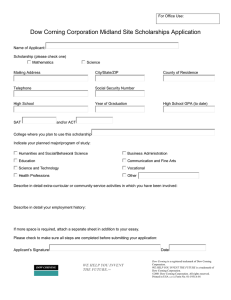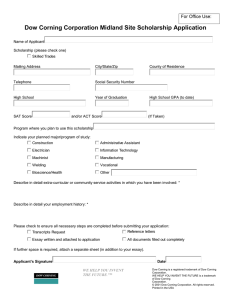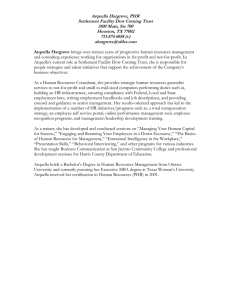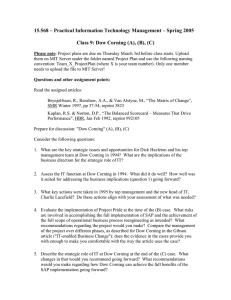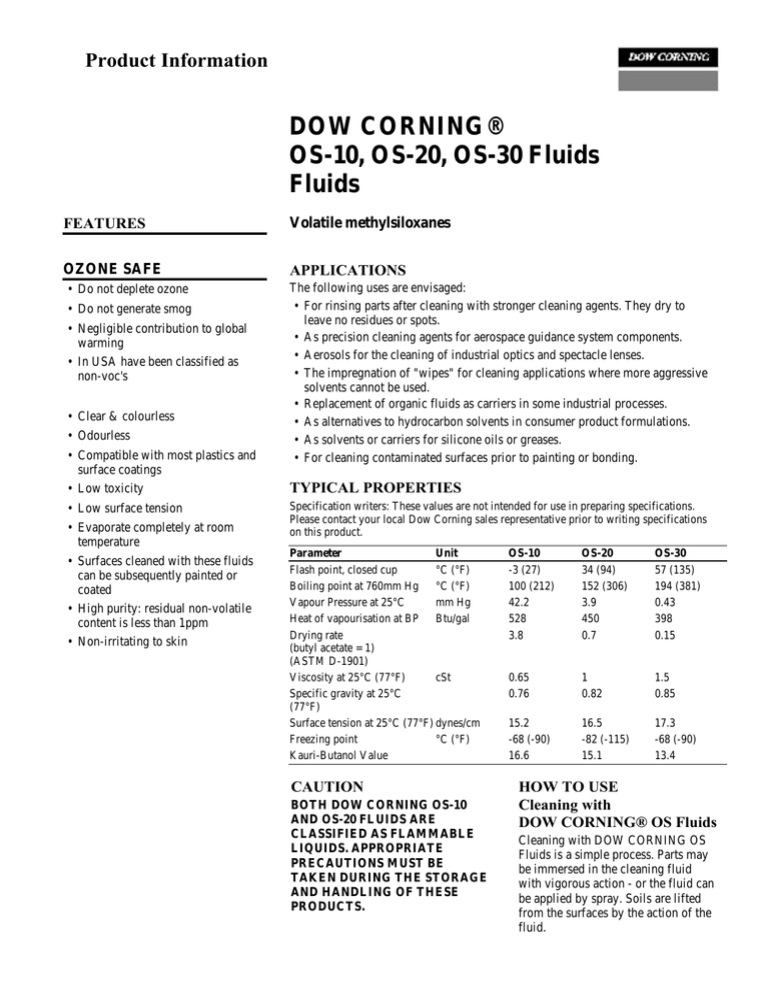
Product Information
DOW CORNING®
OS-10, OS-20, OS-30 Fluids
Fluids
FEATURES
Volatile methylsiloxanes
OZONE SAFE
APPLICATIONS
• Do not deplete ozone
• Do not generate smog
• Negligible contribution to global
warming
• In USA have been classified as
non-voc's
• Clear & colourless
• Odourless
• Compatible with most plastics and
surface coatings
The following uses are envisaged:
• For rinsing parts after cleaning with stronger cleaning agents. They dry to
leave no residues or spots.
• As precision cleaning agents for aerospace guidance system components.
• Aerosols for the cleaning of industrial optics and spectacle lenses.
• The impregnation of "wipes" for cleaning applications where more aggressive
solvents cannot be used.
• Replacement of organic fluids as carriers in some industrial processes.
• As alternatives to hydrocarbon solvents in consumer product formulations.
• As solvents or carriers for silicone oils or greases.
• For cleaning contaminated surfaces prior to painting or bonding.
• Low toxicity
TYPICAL PROPERTIES
• Low surface tension
Specification writers: These values are not intended for use in preparing specifications.
Please contact your local Dow Corning sales representative prior to writing specifications
on this product.
• Evaporate completely at room
temperature
• Surfaces cleaned with these fluids
can be subsequently painted or
coated
• High purity: residual non-volatile
content is less than 1ppm
• Non-irritating to skin
Parameter
Unit
Flash point, closed cup
°C (°F)
Boiling point at 760mm Hg °C (°F)
Vapour Pressure at 25°C
mm Hg
Heat of vapourisation at BP Btu/gal
Drying rate
(butyl acetate = 1)
(ASTM D-1901)
Viscosity at 25°C (77°F)
cSt
Specific gravity at 25°C
(77°F)
Surface tension at 25°C (77°F) dynes/cm
Freezing point
°C (°F)
Kauri-Butanol Value
CAUTION
BOTH DOW CORNING OS-10
AND OS-20 FLUIDS ARE
CLASSIFIED AS FLAMMABLE
LIQUIDS. APPROPRIATE
PRECAUTIONS MUST BE
TAKEN DURING THE STORAGE
AND HANDLING OF THESE
PRODUCTS.
OS-10
-3 (27)
100 (212)
42.2
528
3.8
OS-20
34 (94)
152 (306)
3.9
450
0.7
OS-30
57 (135)
194 (381)
0.43
398
0.15
0.65
0.76
1
0.82
1.5
0.85
15.2
-68 (-90)
16.6
16.5
-82 (-115)
15.1
17.3
-68 (-90)
13.4
HOW TO USE
Cleaning with
DOW CORNING® OS Fluids
Cleaning with DOW CORNING OS
Fluids is a simple process. Parts may
be immersed in the cleaning fluid
with vigorous action - or the fluid can
be applied by spray. Soils are lifted
from the surfaces by the action of the
fluid.
Lightly contaminated components can
be cleaned by wiping them with
tissues impregnated with
DOW CORNING OS Fluids.
DOW CORNING OS Fluids are
compatible with a wide range of
materials and will not harm most
substrates, including most plastics and
delicate coatings. Their mild cleaning
action also makes them suitable for
cleaning multi-material components
and devices. However, it is advisable
to check the compatibility of the
DOW CORNING OS Fluid with the
surfaces to be cleaned.
DOW CORNING OS Fluids are
excellent solvents for non-volatile
silicone materials. Contaminated
surfaces that have been cleaned with a
DOW CORNING OS Fluid can be
subsequently coated or bonded
because the DOW CORNING OS
Fluid will completely evaporate leaving no trace of silicone.
ENVIRONMENTAL
STATUS
DOW CORNING OS Fluids are pure
methyl polysiloxanes and are low in
toxicity and do not contribute to
ozone depletion. Their lifetime in the
atmosphere is between 10 and 30
days. The ultimate oxidative
degradation products are carbon
dioxide, silicic acid and water. As a
result they will not form smog or
create ozone at lower altitudes and
any contribution to global warming
will be insignificant due to the short
atmospheric half-life.
DOW CORNING OS Fluids are
exempt from US Federal VOC
regulations and are included on the
list of acceptable precision and
electronics cleaning substances in the
US "Significant New Alternatives
Policy" also known as SNAP.
RECYCLING
The ability to recycle solvents is
important from an environmental and
economic standpoint. Because
DOW CORNING OS Fluids are
single component materials, they can
be purified by distillation. They can
also be recovered by filtration, gravity
separation or desiccant water removal,
thus extending the life of the fluid.
Heavily contaminated
DOW CORNING OS Fluids are
2
Ref. no. 10-1198-01
classified as ignitable waste and must
be transported and disposed of in an
appropriate manner.
FLAMMABILITY OF
DOW CORNING OS FLUIDS
DOW CORNING OS-10, OS-20,
OS-30 Fluids exhibit closed cup flash
points which place them in the
flammable or combustible range of
materials. Table 1 summarises the
important flammability properties of
OS Fluids. Note that the vapour
pressure of OS-10 results in an ability
to reach the Lower Explosive Limit
(LEL) without heating, and that
DOW CORNING OS-20 requires
only modest heating above ambient
temperature to reach its LEL.
DOW CORNING OS Fluids should
be handled and stored in accordance
with all applicable fire safety laws and
regulations. As with any flammable or
combustible liquid, fire safety can be
addressed through the elimination of
ignition sources, displacement of
oxygen, or suppression of flammable
vapour formation to levels well below
the LEL of the particular liquid.
Dow Corning recommends that OS
Fluids be stored in closed containers,
away from heat, sparks, and open
flames, and used only in processes
which have been engineered to be
operated within well-defined
parameters of fire prevention.
Documents published by the National
Fire Protection Association (NFPA)
are a good resource and guide for
designing such processes.
EXTINGUISHMENT
GUIDELINES
Dow Corning scientists and engineers
have studied, and continue to study,
the dynamics of Volatile Methyl
Siloxane (VMS) fires, including those
involving OS Fluids. These studies
have shown the products of complete
combustion to be carbon dioxide,
water, and amorphous silica. The
VMS-fuelled flame is described as a
characteristic luminous, yellow-white
with tan-grey or white-grey smoke
that is somewhat lighter in colour than
that resulting from hydrocarbon fires.
VMS fluids tend to burn more rapidly
than hydrocarbons of comparable
volatility. This has been attributed to
two possible factors. First, heat
capacities and heats of vaporisation at
the boiling point are lower for the
siloxanes than for organics. Thus, the
total energy required to vapourise
these materials is lower. Secondly,
energy feedback from the flame to the
fuel is enhanced by the influence of
silica on the emission characteristics
of the flame.
The rapid and accelerating nature of a
VMS fire results in a greater degree of
difficulty of extinguishment as the
heat flux increases. Tests on large
pools of VMS liquid have shown CO£
and dry chemical extinguishers to be
ineffective once the fire has reached
certain proportions of size and heat
flux. However, CO£ can extinguish a
smaller VMS fire if applied properly
in the early stages.
Foam has been found to be the most
effective fire extinguishing agent for
VMS fires. Specifically, AFFF
(>30:1) alcohol-resistant, medium
expansion foam, such as
ANSULITE®¹ 3x3 foam has been
shown to work well. Consult your
plant safety group or local fire
fighting unit for application
recommendations.
A fine water spray can also be an
effective method of extinguishment. It
is theorised that the water serves to
significantly cool the fire, allowing
the combustion product silica to
return to the surface of the liquid.
When a sufficient layer of silica has
formed, contact between fuel vapours
and oxygen is inhibited, and the fire is
extinguished.
Dow Corning is committed to further
studies of VMS fire properties, as
well as the identification of all
effective extinguishing agents, and
will communicate its findings to its
customers as they become available.
¹ ANSULITE® is a registered
trademark of Ansul Inc.
HANDLING PRECAUTIONS
Recommended occupational limits for
vapours of these products are given in
the Product Safety Data Sheet.
DOW CORNING OS Fluids can be
used in cleaning equipment
PROVIDED IT IS DESIGNED TO
SAFELY HANDLE FLAMMABLE
OR COMBUSTIBLE LIQUIDS.
Contact the equipment manufacturer
for specific recommendations.
Direct contact with eyes may cause
temporary discomfort which can be
relieved by flushing them with water.
Empty containers should be carefully
ventilated to prevent build-up of
flammable vapours from residual
fluid.
DOW CORNING OS Fluids can
generate static electricity when they
flow in pipework and it is
recommended that conductive metal
pipework is used. Also, the use of
plastic handling components should
be minimised. Precautions must be
taken to ensure that static charge does
not build up to a level where it may
become a shock hazard or cause a
discharge capable of ignition.
PRODUCT SAFETY
INFORMATION REQUIRED FOR
SAFE USE IS NOT INCLUDED.
BEFORE HANDLING, READ
PRODUCT AND SAFETY DATA
SHEETS AND CONTAINER
LABELS FOR SAFE USE,
PHYSICAL AND HEALTH
HAZARD INFORMATION. THE
SAFETY DATA SHEET IS
AVAILABLE FROM YOUR LOCAL
DOW CORNING SALES
REPRESENTATIVE.
USABLE LIFE AND
STORAGE
When stored at or below 0°C in the
original unopened containers these
products have a usable life of 40°C
months from the date of production.
PACKAGING
These products are supplied in drums
(approx. 200 litres) and in 25 litre
pails.
SHIPPING LIMITATIONS
DOW CORNING OS-10 and
DOW CORNING OS-20 Fluids are
classified as "FLAMMABLE
LIQUIDS". DOW CORNING OS-30
3
Ref. no. 10-1198-01
is classified as "COMBUSTIBLE
LIQUID". Detailed information is
given in the Product Safety Data
Sheets.
LIMITATIONS
This product is neither tested nor
represented as suitable for medical or
pharmaceutical uses.
HEALTH AND
ENVIRONMENTAL
INFORMATION
DOW CORNING OS Fluids have
been studied for their toxicological
properties and show a low order of
mammalian and environmental
toxicity.
To support customers in their product
safety needs, Dow Corning has an
extensive Product Stewardship
organization and a team of Health,
Environment and Regulatory Affairs
specialists available in each area.
For further information, please
consult your local Dow Corning
representative.
WARRANTY
INFORMATION - PLEASE
READ CAREFULLY
The information contained herein is
offered in good faith and is believed
to be accurate. However, because
conditions and methods of use of our
products are beyond our control, this
information should not be used in
substitution for customer's tests to
ensure that Dow Corning's products
are safe, effective, and fully
satisfactory for the intended end use.
Dow Corning's sole warranty is that
the product will meet the
Dow Corning sales specifications in
effect at the time of shipment. Your
exclusive remedy for breach of such
warranty is limited to refund of
purchase price or replacement of any
product shown to be other than as
warranted. Dow Corning specifically
disclaims any other express or implied
warranty of fitness for a particular
purpose or merchantability. Unless
Dow Corning provides you with a
specific, duly signed endorsement of
fitness for use, Dow Corning
disclaims liability for any incidental
or consequential damages.
Suggestions of use shall not be taken
as inducements to infringe any patent.
Table 1: Flammability Properties of DOW CORNING OS Fluids
Product
Vapour
Pressure,
25°C (77°F)
(Torr)
Saturated
LEL
UEL
Flash Point DOT Class
Vapour
(Vol%) (Vol%) °C (°F)
Concentration
(Vol %)
NFPA Class Autoignition
Temperature,
°C(°F)
DOW CORNING OS-10
42.2
5.55
1.25
18.6
-2.8 (27)
Flammable Class IB
DOW CORNING OS-20
3.9
0.5
0.9
13.8
34.4 (94)
Flammable Class IC
DOW CORNING OS-30
0.43
0.06
0.9
-*
57.2 (135) Combustible Class II
* Could not be measured due to apparatus temperature constraints. Estimated to be in the 10-15% range.
4
05/01/1998
Ref. no. 10-1198-01
DC 3138
341.1 (646)
350 (662)
350 (662)
® DOW CORNING is a registered trademark of Dow Corning Corporation.
©1997-2001 Dow Corning Corporation. All rights reserved.

